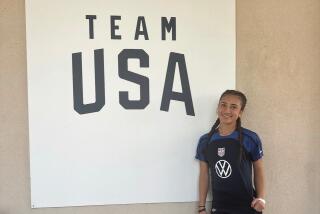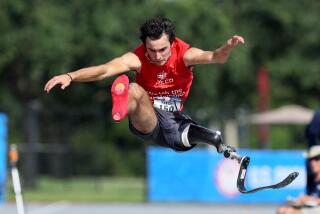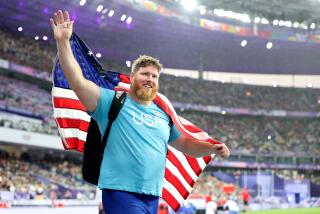Eager to Jump Back Into Competition : CS Northridge’s Burke Nears Clearance for Takeoff After Being Sidelined Since ’89 NCAA Track Championships
Like many track and field coaches, Charlie DiMarco videotapes his high jumpers during competition so he can analyze their technique and adjust their form.
It’s a necessary part of the job, but DiMarco filmed a coach’s nightmare at last year’s NCAA Division II championships at Hampton (Va.) University.
Two athletes he coaches, Ken Burke and Walt Stewart of Cal State Northridge, had qualified for the meet, and as the first jumper in the finals, Burke could set the competitive tone for the Matadors.
To clear the opening height of 6 feet, 8 3/4 inches impressively would serve as an inspiration to Stewart and put pressure on the rest of the field--but that never happened.
Six strides into his 10-step approach, Burke, who cleared 7-2 and won the 1984 state title as a Westlake High junior, crumpled to the ground when his left Achilles’ tendon snapped.
“I just heard a pop, and saw Kenny go down,” said DiMarco, who viewed it through the eyepiece of his video camera. “I thought he’d just caught a spike on the surface and tripped. I was thinking, ‘How embarrassing.’ ”
But when DiMarco approached a writhing Burke, he knew something was seriously wrong. There was a lump above Burke’s left ankle where his Achilles’ tendon had recoiled after rupturing from the heel.
“The first thing that went through my mind was that I was never going to walk again,” said Burke, who hopes to jump in the Mt. San Antonio College Relays in Walnut--his first meet since the injury--next weekend. “I mean, I was really scared. I started getting sick to my stomach and then I went into shock. But once I realized what had happened and calmed down, I was OK. I just watched (Stewart) and the rest of the competition.”
While Stewart proceeded to win the event at 7-0 1/2, Burke was already gearing up for his rehabilitation.
“I thought he was going to be as low as you can get right after it happened,” Stewart said. “But there was no hint of him being down. Right from the start, he began to look ahead to this season. There was never any doubt that he’d come back.”
After the tendon was surgically reattached, Burke spent four weeks in a full-leg cast, another month in a half-cast that started just below the knee, and an additional three weeks in a fiberglass ankle brace that allowed his left foot more flexibility.
From there, he progressed to walking (three months after the surgery), jogging (four) and, finally, sprinting (six).
“It’s been hard,” said Burke, whose return to competition has been delayed several times by an assortment of injuries. “There’s been more bad than good. I received a lot of support from my family and friends, but it’s been very frustrating at times.”
Usually a gregarious, easygoing person, Burke was climbing the walls after a couple of weeks in a cast, according to his girlfriend, Katie Wallace.
“Over a period of time, he kind of got down on himself,” she said. “He was tired of people waiting on him. He wanted to be on his own.”
Burke’s mother, Edie, compared her son to a grounded pilot.
“He was used to flying high,” she said. “Not being able to really set him back.”
The Achilles’ injury was only one of many setbacks in Burke’s high-jumping career. A career that soared at the start 13 years ago has stagnated in recent seasons.
Burke, 23, was an age-group phenom. He cleared 5-2 in 1977 when he was 10, and set a national age-11 record of 5-5 the next year.
He improved to 5-8 when he was 13, and 6-4 at 14. During his freshman year at Westlake High, he scaled 6-7, then cleared 6-8 1/2 in a summer meet.
As a high school sophomore, he finished second in the 1983 state championships at Bakersfield, clearing a personal best of 7-1, and nearly upset Maurice Crumby of Balboa High in San Francisco. Crumby had passed at 7-1 but made 7-2 on his third and final attempt.
In 1984, Burke raised his personal best to 7-2 and jumped 7-0 to win the state title at the Coliseum.
“Looking back, (the high jump) was just something I did back then,” Burke said. “I learned to love it later.”
That devotion has been tested several times.
Sciatic-nerve problems sidelined Burke during his senior season. Then his father, Fred, who supported his early start in track and field, died of colon cancer shortly before he graduated.
“That was a pretty traumatic experience,” Burke said. “It was just a very trying time.”
Despite his absence from competition, Burke was recruited by several schools, including Texas A & M, Arkansas, Arizona, Arizona State and Cal.
He signed a letter of intent with Texas A & M on the first signing day, but never felt comfortable at the Southwest Conference school and transferred to Moorpark College after his sophomore season in 1987.
“One of the reasons I went (to A & M) was that they were really starting to build their track program up,” said Burke, who cleared 7-0 as a freshman and 7-2 as a sophomore. “I mean, the first year I was there, Floyd Heard (personal best of 19.95 seconds in the 200 meters), Randy Barnes (74-4 1/4 in the shotput) and Stanley Kerr (10.10 in the 100) were all on the team.”
Ironically, that wealth of talent, combined with homesickness and culture shock, contributed to Burke’s decision to leave the school. The leader at Westlake, Burke was just one of the pack at College Station.
“They really didn’t have a high-jump coach, and I needed that,” Burke said. “It wasn’t like that with Charlie. He knows me as a jumper, and I’m starting to know myself. . . . But down there, I never had that feeling.”
Burke, who met DiMarco when he was working out at Moorpark, figured he’d end up at USC. But when the Trojan coaches started to balk at giving him a scholarship, he enrolled at Northridge in the spring semester of last year.
He struggled with his technique for most of the 1989 season, placing only sixth (6-6 3/4) in the California Collegiate Athletic Assn. championships. But he qualified for the Division II meet with a clearance of 7-0 1/2 at Cal State Los Angeles a week before the nationals.
“When he got to (the NCAAs) last year, he looked awesome,” DiMarco said. “He was ready to fly. Everything was coming together. He was the guy that everyone else had to beat in that meet.”
Burke concurred with his coach.
“My warm-up jumps were some of the best jumps I’ve ever had in my life, technically,” he said. “I thought I was ready for a (personal record). But (the Achilles’ tendon) just popped on me in the final. . . .”
Coming back from the injury has been a hit-and-miss proposition for Burke.
The tendon has healed, but the psychological effects of the injury still trouble the 6-foot-2 1/2, 184-pound jumper.
“My strength is as good as it’s ever been,” Burke said. “I’m pretty much as strong as I can be with the weights, but I don’t have the jumping strength yet. . . . There’s still a tendency to hold back just a little. I was real aggressive in a workout a couple of weeks ago, but there’s still some doubt. Once I feel comfortable, I can start going all-out again.”
DiMarco, who coaches the Northridge-based Advantage Athletics Track Club, hopes Burke will enter his comfort zone by May, just in time for the CCAA and NCAA championships.
“We don’t want to put any type of time pressure on him right now,” he said.
“We just want him to improve week by week. Kenny’s a very coachable athlete. He’s very receptive to my ideas about high jumping so I think he’ll be OK.”
Burke’s high-jumping future might hinge on how he performs this season.
If he doesn’t jump well, it might be over. But if he makes sufficient progress, he plans to continue at the post-collegiate level.
“I’d like to keep jumping until I can’t jump any more,” Burke said. “It’s such a challenge. It’s a sport that combines power with grace. It combines physics and art, and that appeals to me. A good jump is like a good golf swing, it’s very pleasing to watch. . . . I’d like to make a career out of it if I could.”
DiMarco figures Burke can if he’s healthy.
“He probably has as much raw potential as any athlete I’ve worked with. He’s got the build. He’s got the long legs and he’s got the high center of gravity.
“He’s thin and he’s fast enough. . . . If he’s 100%, I think he could be a 7-7 or a 7-8 high jumper in the long run. And after that, who knows? Anything can happen.”
More to Read
Go beyond the scoreboard
Get the latest on L.A.'s teams in the daily Sports Report newsletter.
You may occasionally receive promotional content from the Los Angeles Times.






